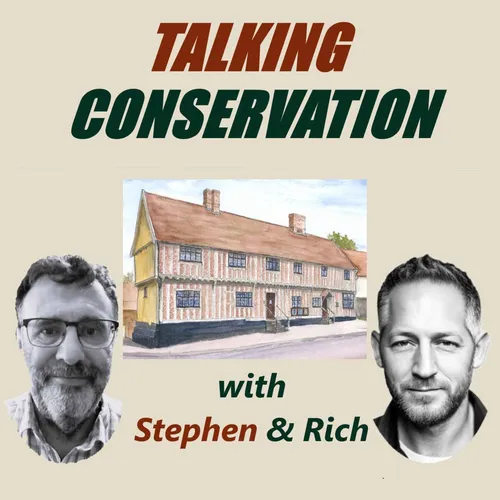Lime Mortar Details That Matter – Drip Detailing, Exposure & High-Level Repairs
- Author
- Stephen Boniface and Rich Alesbury
- Published
- Fri 08 Aug 2025
- Episode Link
- https://podcasters.spotify.com/pod/show/talking-conservation/episodes/Lime-Mortar-Details-That-Matter--Drip-Detailing--Exposure--High-Level-Repairs-e36ia6a
What’s the biggest threat to your historic building? Water.
In this special episode of Talking Conservation, we’re joined by Steve Hogarth — SPAB Fellow, heritage mason, and rope access conservator with Highlife Rope Access — to explore how the smallest details up high can make the biggest difference to your building’s long-term health.
We dig into:
- Why effective drip detailing is critical to keeping water off your building
- What causes damage when high-level details are missing or poorly repaired
- Sky-facing joints and how they differ from vertical surfaces
- How to assess and choose the right lime mortar mix for exposed locations
- The overlooked genius of traditional detailing (like string courses, throatings & hood moulds)
- When to use NHL, hot lime, or natural cements- Why small targeted maintenance can prevent costly full-scale repairs
- Real-world insight from Steve’s rope access conservation work on churches and historic buildings
This is an essential listen for homeowners, tradespeople, or professionals working with older or listed buildings.
Chapters:
00:00 Introduction
01:57 Drips and throatings
06:44 Impact of the Grand Tour
07:35 Umbrellas for buildings!
09:13 Clogged details and past rebuilding
10:28 Water pathways and identifying problems
12:59 Stephen's anecdote about finding a leak
15:01 Stopping water getting in
16:54 Junctions between materials
17:38 Choice of material for repair
19:56 Mortar mixes for exposed areas
24:38 Dealing with coastal locations
27:21 Ongoing maintenance
29:04 Limewashing or covering and changing exposed elevations
31:08 Shedding and sky-facing surfaces
35:02 Concluding comments
35:54 Outro
👉 High Life Rope Access: https://www.highliferopeaccess.com/
👉 Need expert 1:1 advice for your traditional or historic home?Book a video consultation with an independent specialist at www.expertible.com
🎓 Professionals wanting mentoring or training with Stephen Boniface? Visit www.beconservation.com
🔔 Subscribe for more episodes on lime, building conservation, materials, and expert insights from tradespeople working at the sharp end.
